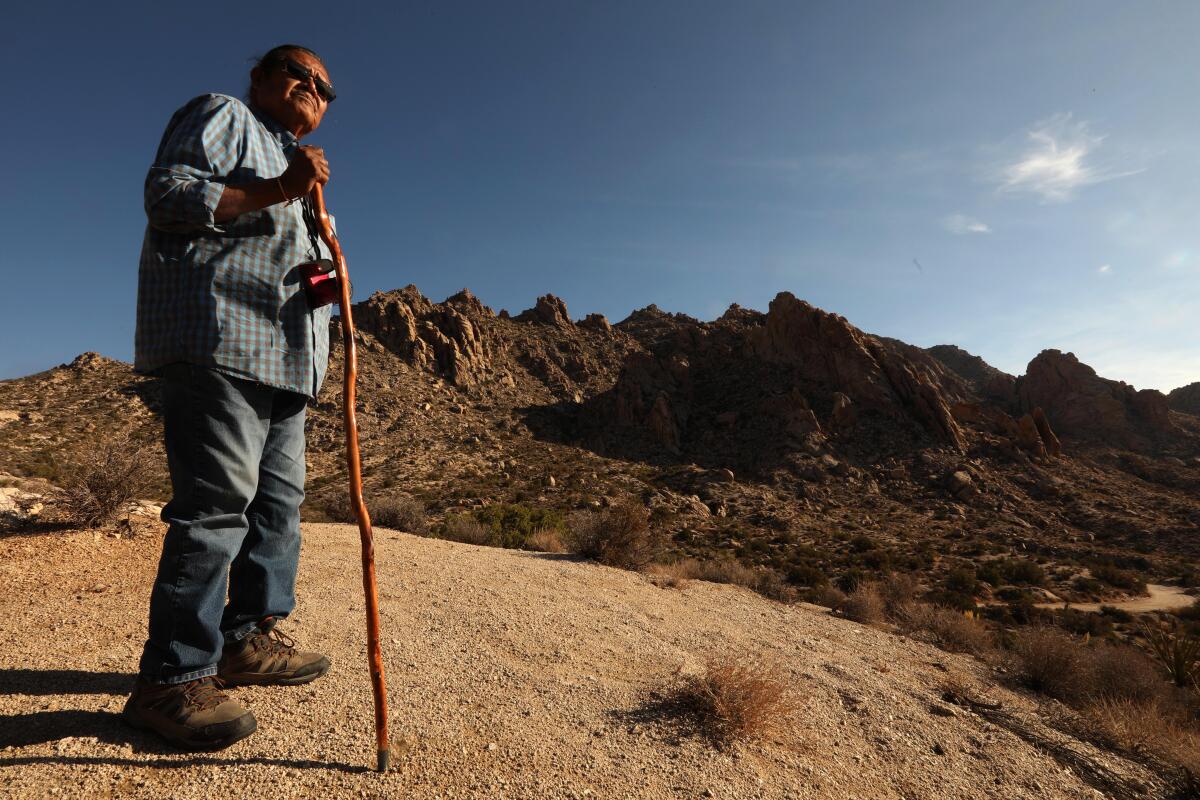Opinion: Nevada can’t shed its ugly past while continuing to exploit Native people and lands

Today, tourists from all over the world flock to Nevada to experience selective amnesia. “What happens in Vegas stays in Vegas,” the slogan goes. But Las Vegas’ culture of forgetting is more than drunken hijinks. The city’s existence depends on forgetting the colonial violence that made the Southwest. Since becoming a state in 1864, Nevada’s basic political and economic infrastructure is a product of the expropriation of Native American lands.
If any one Nevadan represents this history, it’s Patrick “Pat” Anthony McCarran, the Democratic U.S. senator who served the state from 1933 to 1954. McCarran’s name is everywhere in Vegas: on street signs, building names and, until 2021, the Las Vegas International Airport. Many locals remember McCarran for being a champion of the mining and ranching industries; less proudly, they have come to recognize that he was an unabashed antisemite.
For this reason, Clark County commissioners recently rebranded the airport for a different Democratic senator, Harry Reid. Still, in reckoning with McCarran’s legacy, Nevadans sometimes overlook the ways in which even his most laudable successes carried on an ugly tradition of stealing from Indigenous people.
Dispossession began before McCarran’s time, in the 19th century. After Mexico ceded its northern territory to the United States in 1848, decades of violence ensued between white newcomers and Native nations defending their land. In 1863, near what is now the Utah-Nevada border, Western Shoshone leaders signed the Treaty of Ruby Valley for the sake of “peace and friendship.” The treaty acknowledged Native jurisdiction over much of the Intermountain West from Death Valley to Idaho’s Snake River.
Except for limited rights of way, forts and mines, Shoshone delegates neither ceded nor sold any real estate to the federal government. Nevertheless, Nevada became a state the next year, on Oct. 31, 1864. As American settlers began arriving in droves, they treated Newe (Western Shoshone) land — along with that of the nearby Numu (Northern Paiute), Nuwuvi (Southern Paiute) and Washoe nations — as “public domain,” empty for the taking.
McCarran’s father had moved west in 1857 with the California Volunteers, a division of the U.S. Army charged with pacifying Natives along the Sierra Nevada’s eastern slope. After serving, he built a ranch on the lower Truckee River, east of Reno. His son, Pat, was born on Aug. 8, 1876, and grew up on the homestead.
Although the younger McCarran was raised to think Native people were vanishing, in reality they were simply adapting to the settler invasion. Some relocated to reservations. Others resettled on the outskirts of mining towns. But most continued to visit traditional territories to gather pine nuts, hunt jackrabbits and perform ceremonies. They also began to mobilize, pursuing treaty rights in the courts as early as the 1920s.
In any event, McCarran inherited his father’s sense of Manifest Destiny. When he entered politics, anti-Indigenous ideas informed his policymaking in ways that continue to shape present-day Nevada. Even as he achieved national influence, serving on the Senate’s powerful Appropriations and Judiciary committees, he pursued parochial goals in his underdeveloped home state. Often his initiatives involved systematically denying Native Nevadans access to resources — particularly water — while redirecting them to his growth-minded constituents.
In one episode, McCarran went out of his way to enable non-Native squatters on the Pyramid Lake Indian Reservation, which he called a matter “of equity and justice toward the white settlers.” Avery Winnemucca, the Pyramid Lake tribal chairman, wrote to Eleanor Roosevelt in 1949, imploring her to lobby Congress against bills McCarran proposed, which would have patented the settlers’ illegal homesteads retroactively. “In defeat our ancestors accepted the white man’s treaties and promises,” Winnemucca reminded the former first lady. “Then why does Sen. McCarran propose the Congress of the U.S. to blow its nose on the American flag?” Although the immediate bills died, non-Native farmers would continue to contest the reservation’s limited water supply for decades after.
McCarran also pursued his vision of aggressive growth by soliciting military installations on the Nevada desert’s vast, “open” public lands. Nellis Air Force Base (originally an airstrip called McCarran Field, north of Las Vegas) and Naval Air Station Fallon near Reno, both established during World War II at McCarran’s urging, today represent two of the largest defense properties in the United States.
His crowning achievement came in 1950, with the creation of America’s first permanent continental nuclear weapons testing site, the Nevada Proving Grounds (later, the Nevada Test Site). Over the next 40 years, the Atomic Energy Commission (later, the Department of Energy) would detonate nearly a thousand fission devices above and below the 1,300-square-mile restricted zone.
The site was in the heart of the territory of the Western Shoshone, which they call Newe Segobia. In the 1980s, citing violations of the Ruby Valley Treaty, Newe land defenders, along with non-Indigenous pacifists and environmentalists, began protesting outside its gates. The coalition of organizers drew thousands of demonstrators to the desert each spring to peacefully gather and pray for an end to colonial occupation.
To this day, much of the region remains a highly restricted — and toxic — military zone. Native downwinders suffer some of the highest rates of cancer in the nation, probably related to radiation exposure from consuming contaminated game and wild plants in traditional diets.
Pat McCarran achieved his vision for the desert: When he died in 1954, Las Vegas was one of the fastest growing cities in the country. Southern Nevada now contains over 2 million people, with a Native population of less than 1%.
Growth continues to be a point of pride for state leaders. Recent development measures include expanding the Naval range’s footprint, doubling down on wasteful settler water laws, and transforming Nevada into a “lithium loop,” an all-in-state critical-mineral supply chain. Despite allowing for more citizen and tribal participation — and an ostensibly “green” goal in lithium-ion battery production — the current development agenda channels McCarran’s extractive goals and disregard for Native land rights.
In some ways, things are getting better. Nevadans are rethinking McCarran’s legacy in public spaces. And last month, after years of advocacy efforts by Indigenous land defenders, the Biden administration established a half-million-acre national monument surrounding Avi Kwa Ame, or Spirit Mountain, in southern Nevada. The designation will, at last, protect land considered sacred by Yuman-speaking people of the lower Colorado River.
But decolonizing Nevada will require a more fundamental reevaluation of basic ideas about development, growth and resource exploitation at the core of the state’s economy. Although the region faces a megadrought, McCarran’s vision still drives much of the state’s policies. Until that changes, Nevada, along with much of the American West, is living on stolen land and borrowed time.
Taylor Rose is a PhD candidate at Yale University. He researches mining, militarization and Native American history in the American West. This article was produced in partnership with Zócalo Public Square.
More to Read
A cure for the common opinion
Get thought-provoking perspectives with our weekly newsletter.
You may occasionally receive promotional content from the Los Angeles Times.






